Instructions for beginner gardeners: how to root a rose from a bouquet at home
A bouquet of roses is a romantic gift, which is most often presented by men to the fair sex. Of course, such a sign of attention improves your mood, but from a practical point of view, the gift is short-lived. However, experienced flower growers know that the life of flowers can be extended for more than one year by rooting their cuttings and planting them in a garden or pot.
Rose is a capricious plant. The more exotic the color of the bud, the more difficult it is to work with the flower. Despite this, it is possible to plant almost any material. How to root a rose from a bouquet at home and how to care for it afterwards, read our article.
Which roses from a bouquet can be rooted
It is possible to propagate roses from a purchased bouquet. Flower stems are rooted at home and then grown in an apartment or garden. Such a plant will remind you of the person who gave the flowers for many years.
How easy it is to grow a rose from a cutting depends on the shade and origin of the flowers. You need to pay attention to the following parameters:
- Color. Red, white, pink and cream roses take root easily - in 80% of cases. Instances of yellow, blue, purple shades, as well as multi-colored ones, throw out roots much worse, but their rooting is also possible.
- Domestic varieties. Rooting of flowers grown in our country occurs faster, since they are more hardy and are often grown without a lot of chemicals.Dutch and other foreign roses grown on an industrial scale are more difficult to propagate. This is due to the use of a large number of growth stimulants and fertilizers. Such roses adapt less well to home conditions.
- Freshness of the bouquet. The longer flowers stand in water, the worse they take root. It is recommended to prepare cuttings immediately after delivering the bouquet home.
- Appearance of buds. If the flowers show signs of infection with diseases and pests (aphids, spots, holes, etc.), they will have to be abandoned. Such seedlings will not survive subsequent cultivation, will become sick and can infect other plants.
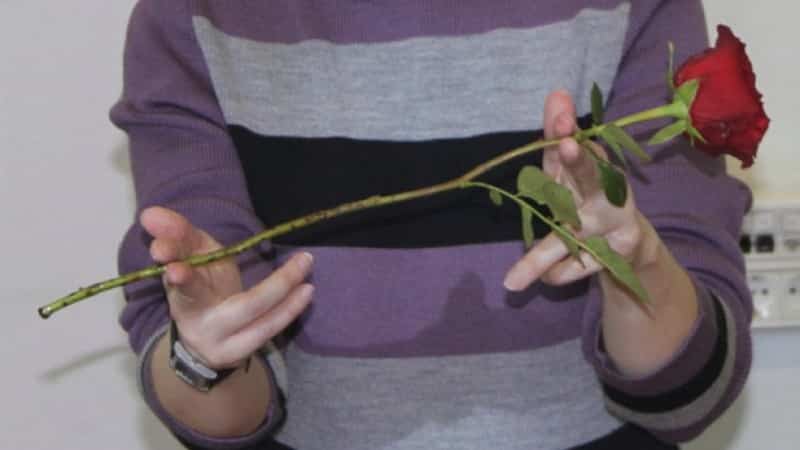
If the bouquet does not fit into the specified parameters, this does not mean that the flowers cannot be rooted. It’s just that the chances that the cuttings will throw out roots and take root are lower.
Note! Some gardeners prefer to use stems from which the petals have already begun to fall off.
Selection and preparation of cuttings
Before cuttings you need to select suitable plants:
- Presence of kidneys. The axillary buds should not be dry and fall off when touched lightly.
- Degree of lignification of cuttings. Completely lignified cuttings with brown stems, as well as green, overly flexible stems, are not suitable. Most likely, they will not throw out their roots, but will rot. For germination, cuttings that are still green but already partially lignified are chosen (these are the stems usually found in roses in a bouquet).
- Stems thickness. The optimal thickness of the handle is equal to the diameter of a standard pencil.
- Appearance. The stems should not have cracks, spots or holes.
It is advisable that the cuttings have 2-3 leaves. In their absence, rooting is also possible, but it will occur more slowly.
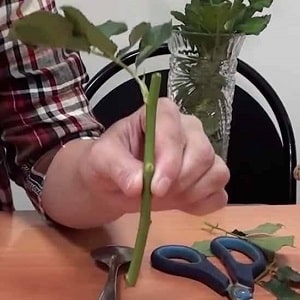 Use the top or center part. You will need a cutting about 15 cm long. It should contain 3-4 living axillary buds. The lower cut is made at an angle of 45° 1 cm below the bud, and the upper cut is made even 1 cm above the bud.
Use the top or center part. You will need a cutting about 15 cm long. It should contain 3-4 living axillary buds. The lower cut is made at an angle of 45° 1 cm below the bud, and the upper cut is made even 1 cm above the bud.- The bottom sheet is torn off, leaving only the petiole. The top 2 are shortened by ½. No more than 3 sheets are left on the planting material, the rest are torn off. Remove all thorns.
- Soak the cuttings for 2 hours in a light pink solution of potassium permanganate, then for a day in a growth stimulator.
The lower part of the stem is not used, since with prolonged exposure to water it darkens, cracks and swells.
Advice. Some gardeners prefer to seal the lower cut of the planting material with paraffin.
Suitable timing
When growing roses from a bouquet, it is important to consider the timing of planting. It depends on them whether the cutting will take root..
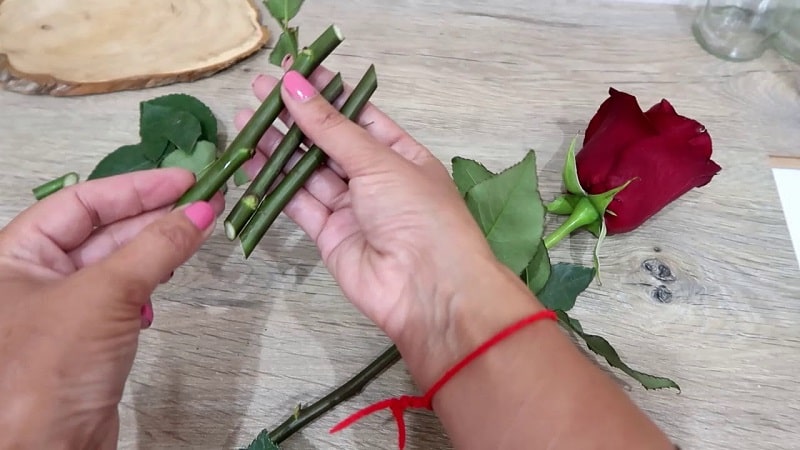
Timing for planting roses from a bouquet:
- Summer. This is the best time to plant roses from a vase. The probability that the cutting will produce roots is 90%.
- Autumn. The first half of autumn is also suitable for growing roses from a bouquet. The probability of their rooting reaches 80%. In late autumn, when daylight hours become short, this probability drops to 50%.
- Spring. In spring, roses take root in 60-70% of cases. The closer to summer, the higher the chances that the plant will take root.
- Winter. In winter, the chances of successfully growing a flower from a bouquet are much lower. They reach 30%, but increase in the presence of artificial lighting.
Interesting things on the site:
Rooting methods
Pink shoots are planted using different methods. Some of them are truly unusual.The chances of rooting are approximately the same in all cases.
In water
Rooting stems in water is the most popular way to propagate purchased flowers from a bouquet.. It requires a minimum of materials and time from the grower. Its disadvantage is that the stems sometimes rot in water. This is avoided with the help of special additives to the liquid.
Step-by-step instructions for planting rose cuttings in water:
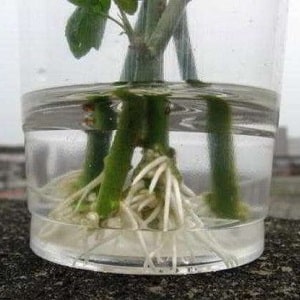 Pour 3-4 cm of liquid into the bottom of the container. To prevent rotting of the stems, add a little potassium permanganate (you should get a light pink solution), Glyokladin (according to the instructions) or Fitosporin (according to the instructions).
Pour 3-4 cm of liquid into the bottom of the container. To prevent rotting of the stems, add a little potassium permanganate (you should get a light pink solution), Glyokladin (according to the instructions) or Fitosporin (according to the instructions).- Cover the container with the cutting with the top of a plastic bottle or bag and put it in a cool, bright place.
- Every day, the cuttings are ventilated for 15 minutes by removing the bag or unscrewing the cap at the top of the bottle. The stem is sprayed with settled water at room temperature.
- The water is changed every 2 days. It is not necessary to add disinfectants every time.
After 2 weeks, roots will begin to form.. After this, the sprout is planted in the ground.
In the ground
You can also propagate roses from a bouquet in the ground. Before this, the bouquet must stand in water for 24 hours..
The soil is used purchased (special for roses and other flower plants) or prepared independently from equal parts of garden soil, sand and peat. The soil must be disinfected with a dark pink solution of potassium permanganate or baked in the oven.
How to propagate a rose in the ground:
- The container is filled with soil and drainage. “Glyokladin” or “Fitosporin” is placed on the bottom. The soil is watered abundantly.
- The lower cut of the cutting is dipped into dry “Solution” or “Kornevin”.Then they stick it into the ground so that it stands without support.
- The top of the cutting is covered with a bag or a cut bottle. Every day the shoot is ventilated for 15 minutes.
- The seedling is placed on a southern windowsill and grown at room temperature. As the top layer of soil dries, the rose is watered with warm, settled water.
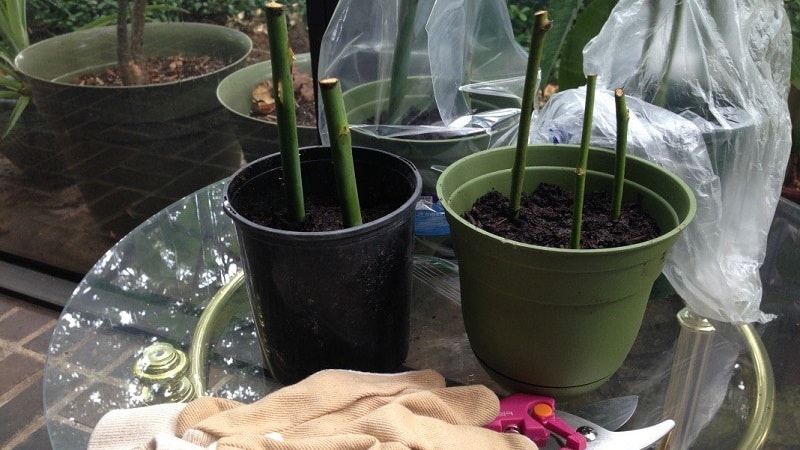
The formation of leaves and shoots indicates that the seedlings have taken root.. After this, the duration of ventilation begins to increase. Then the greenhouse is dismantled.
Note! It is important to ensure that the water does not stagnate, otherwise the stems will rot. There should be holes in the bottom of the containers. It is also important to use drainage.
In potatoes
One of the most unusual ways to grow roses – rooting in potatoes. Its advantage is that the raw root vegetable contains a sufficient amount of moisture, as well as nutrients necessary for rooting of the cutting.
How to plant a rose in potatoes:
- Large potatoes are washed from the soil. They check that there are no traces of diseases and pests on it. All eyes are removed.
- Use a knife to make a small hole in the root vegetable. The cutting is stuck into it with the pointed part.
- The potatoes are placed in a deep container and covered with soil so that one pink bud is underground.
- Water the soil with warm sweet water (2 teaspoons of sugar per 1 cup of water). Then the containers with the cuttings are covered with film or a bag.
- Every day, the seedlings are ventilated for 15 minutes and sprayed with warm water from a spray bottle. Once every 5 days the soil is moistened.
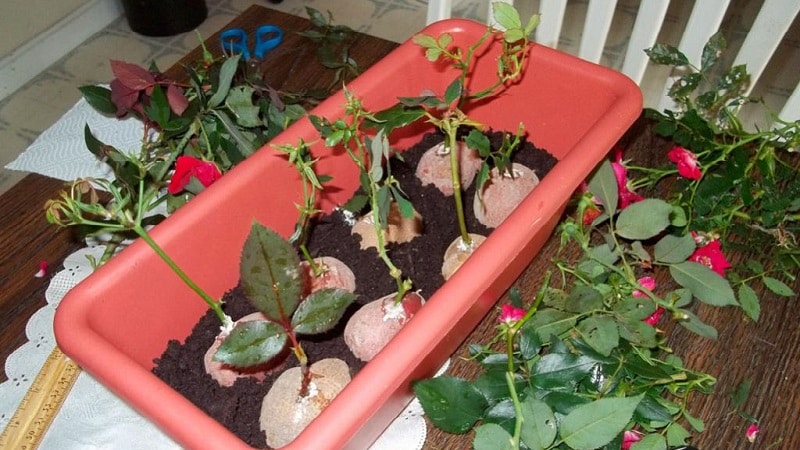
When leaves and shoots begin to form on the rose, the duration of ventilation is increased.. Then the greenhouse is removed and the plant is transplanted into the ground.
In the package
It is possible to germinate pink stems using only a bag and newspapers. This another interesting way to propagate flowers from a bouquet:
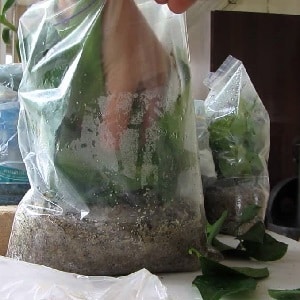 At the bottom of a large plastic bag, lay newspaper torn into pieces in several layers. Some gardeners prefer to use crumpled whole sheets.
At the bottom of a large plastic bag, lay newspaper torn into pieces in several layers. Some gardeners prefer to use crumpled whole sheets.- The newspaper is filled with water with the addition of “Fitosporin” and left until the liquid is absorbed. The inside of the bag is sprayed with water from a spray bottle.
- Prepared cuttings are dipped cut side into a dry root formation stimulator (“Kornevin”) and placed in newspaper.
- The bag is tied at the top and leaned against a support. This method is convenient for germinating a large number of cuttings.
- As the newspaper dries, moisten it with warm, sweet water. It is not the rose that is sprayed from the spray bottle, but the inside of the bag.
- The package is opened daily for 15 minutes for ventilation.
When the roots appear, the rose is replanted into the ground.
Advice. Flower growers recommend taking several pink cuttings and growing them in different ways.
How to root a rose: step-by-step instructions
After roots appear on the cuttings, they are transplanted into a pot of soil. This is done as follows:
- A layer of drainage is poured onto the bottom of the pot with holes. The rest is generally filled with soil. It is watered with a light pink solution of potassium permanganate. After this, the soil is allowed to stand for a day.
- The rose is removed from the place where it was germinated and transferred to a pot. Bury 1 cm above the formed roots.
- The top of the seedling is covered with a plastic bag, glass jar or cut-off bottle. Ventilate for 15 minutes.
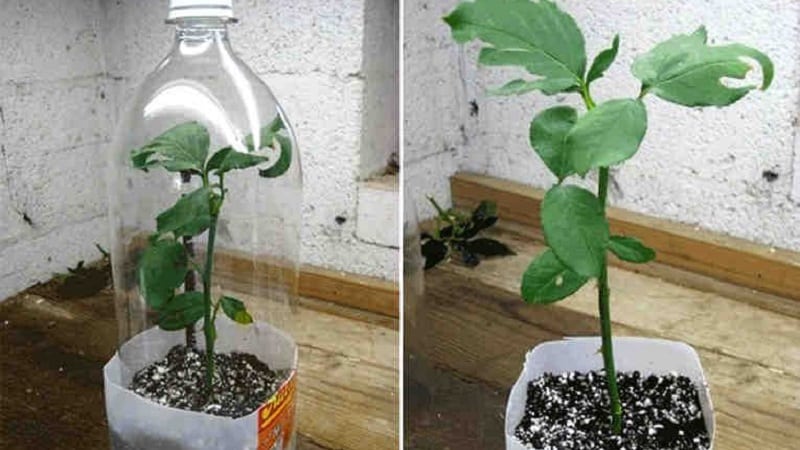
Grow roses at room temperature on a southern windowsill. The greenhouse is dismantled after the leaves appear, after hardening the plant, gradually increasing the ventilation time.
After the film is removed from the plant, it is continued to be sprayed with a spray bottle.. In winter, a humidifier is installed in the room to create optimal humidity levels.
Feeding is applied once a month. Use special fertilizers for flowering plants or a mixture of superphosphate, potassium sulfate and ammonium nitrate.
Read also:
Is it possible to grow petunia as a houseplant?
What to do if the rose itself has given roots in a vase
It is also possible to work with a rose that has taken root on its own in a vase.. When found, such a flower is separated from the main bouquet.
The root system is checked for the presence of rotting shoots. Then cut off the bud and remove excess leaves, leaving 3-4 leaves, cut to half. If the stem is long, it is cut so that about 5 axillary buds remain, in order to allow energy to be spent on strengthening the roots rather than maintaining green mass.
A flower with roots is planted in the ground. The soil is watered with a root formation stimulator. The seedling is sprayed with water with the addition of Epin.
When to replant in the ground
Seedlings are transplanted into the ground the next year after rooting.. For planting, choose a warm time (April or May depending on the region). Before work, the plant is hardened by taking it outside and gradually increasing the time it stays there to a day.
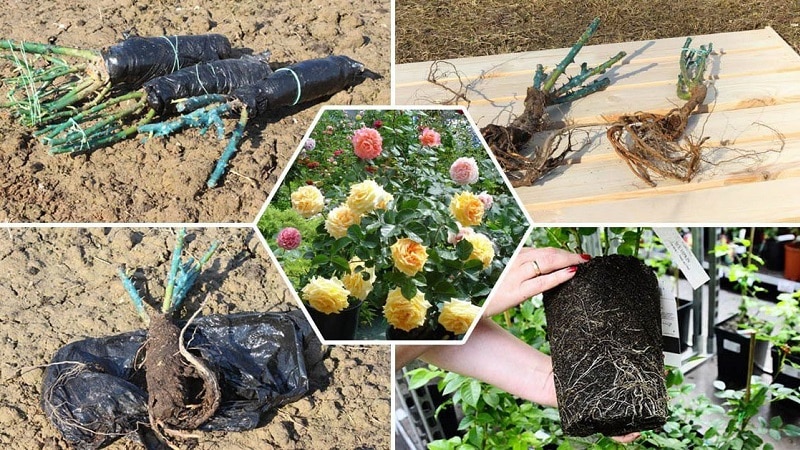
To plant roses, prepare an area in a well-lit place protected from the wind.. It is dug up, cleared of weeds, mixed with 6 kg of humus, 30 g of superphosphate and 25 g of potassium sulfate per 1 sq. m. m.
Dig holes according to the size of the pot in which the rose was located.. It is planted together with a lump of earth, without deepening the root collar. Then water with warm water. At first, the plantings are covered with film at night.
What to do if the cutting does not take root
It is not always possible to root roses from a bouquet at home. In most cases, this occurs due to improper preparation of cuttings. or using varieties that do not produce roots well.
Note! Thick, fatty stems with a reddish tint take root the worst.
If the cutting does not take root, but rots, it is not worth germinating. Any methods will not give results. In this case, you will have to use new planting material.
Use of stimulants
Growth stimulants significantly increase the likelihood of root formation on cuttings. The following products are commonly used for roses::
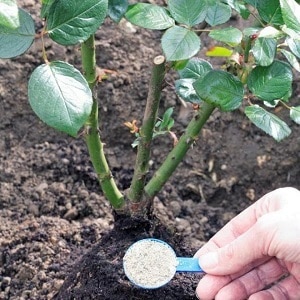 "Heteroauxin". To prepare a solution, take 50 mg of the drug per 1 liter of liquid.
"Heteroauxin". To prepare a solution, take 50 mg of the drug per 1 liter of liquid.- "Zircon". For 1 liter of water take 0.1 mg of the substance.
- "Kornevin". Dilute according to the instructions or dip a cut of the cutting into a dry preparation.
- Honey water. For 1 tbsp. take 1 tsp of water. honey
- Aloe juice. It is diluted with an equal amount of water.
The cuttings are soaked in a solution of a growth stimulator for a day.. Then the seedlings are periodically watered with it.
Advice from experienced flower growers
Experienced gardeners know a few tricks to help you grow flowers:
- Roses take root well in sphagnum moss. Before use, moss is dipped in water at room temperature.
- A rose takes root much faster in the ground than in water. In this case, decay occurs less frequently.
- To prevent the roots from rotting, be sure to use containers with drainage holes.
Conclusion
Many people want to extend the life of roses from a bouquet given by a loved one. Flowers can be given a second life by rooting and planting their stems. They will grow into a beautiful rose bush that will delight you with flowering for many years.
The rooting process is simple. However, whether roots form on a cutting depends on many factors. This is the time of year, the type of flowers, and how long ago they were cut. Therefore, for propagation, several stems from a bouquet are prepared at once.